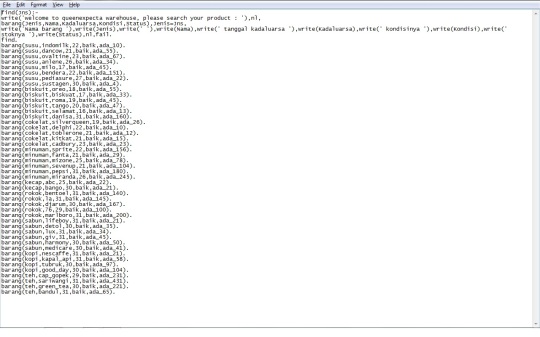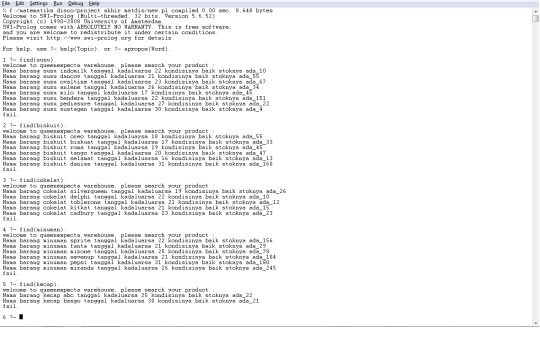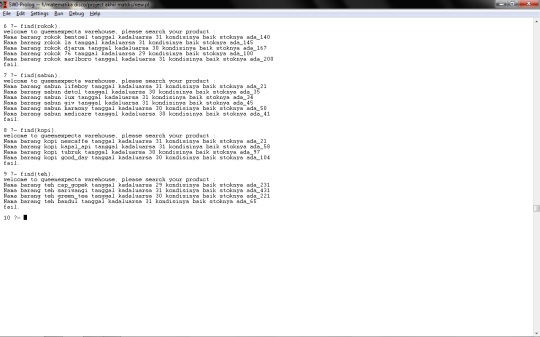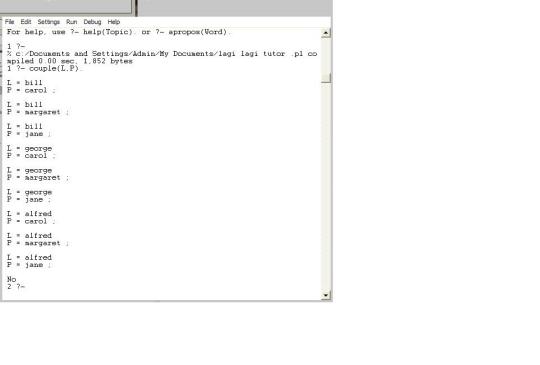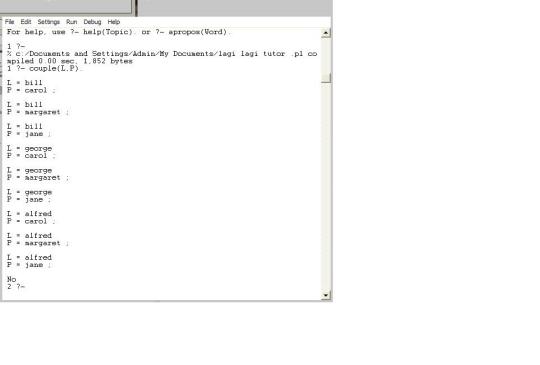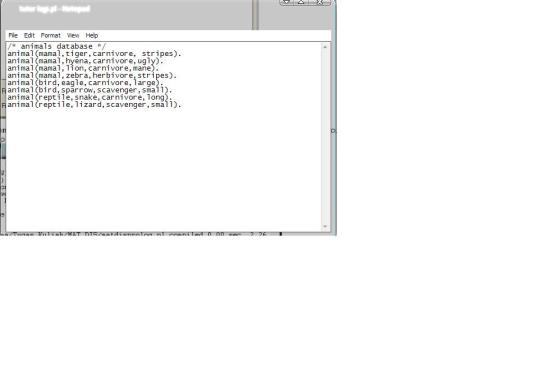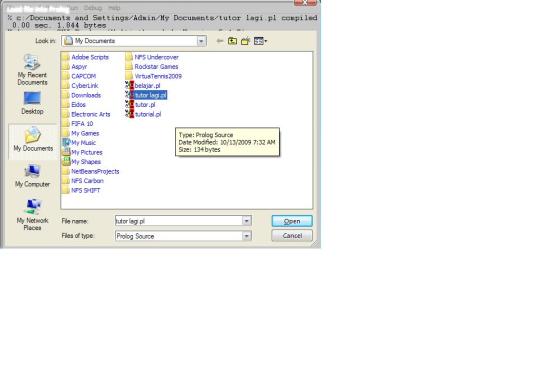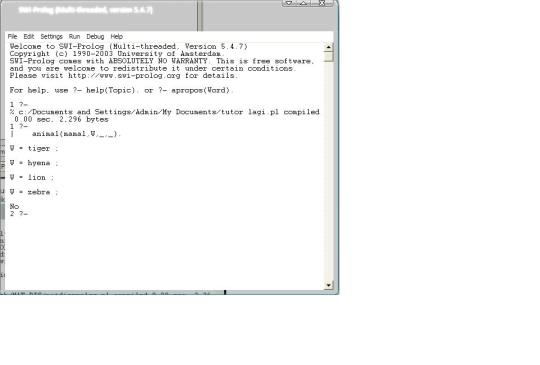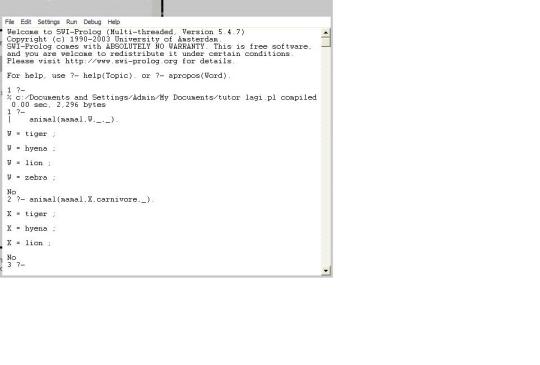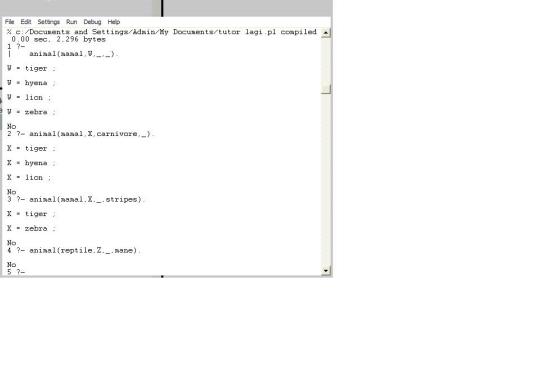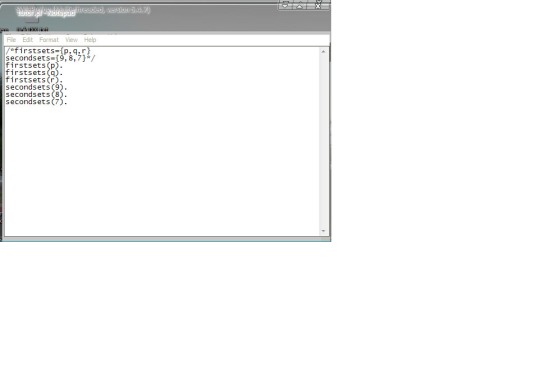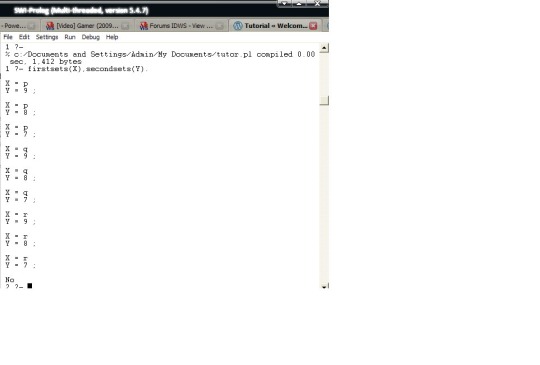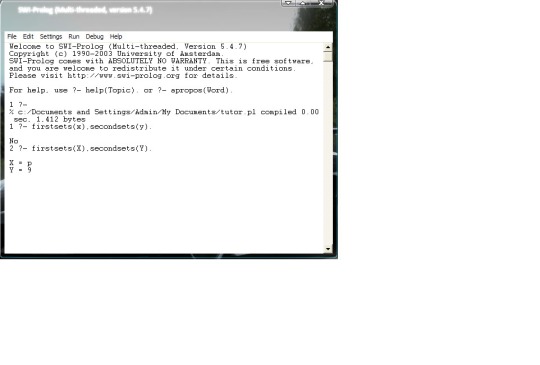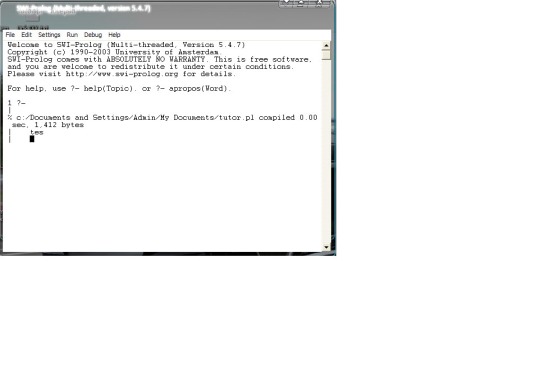LOOPING
(directly), but a similar effect can be obtained using recursion, as shown in the
a given condition is met. Although, as was pointed out in the introduction to this
book, Prolog has no looping facilities, similar effects can be obtained that enable a
example programs below. Which from this point forward we refer to as control statements: the sequence statement, selection statements (three types) and repetition statements (three types). Every program is formed by combining as many sequence, selection and repetition statements as is appropriate for the algorithm the program implements. Each diagram contains an initial state and a final state that represent a control statement’s entry point and exit point, respectively. Single-entry/single-exit control statements make it easy to build programs—we “attached” the control statements to one another by connecting the exit point of one to the entry point of the next. This procedure is similar to the way in which a child stacks building blocks, so we call it controlstatement stacking. We will learn that there is only one other way in which control statements may be connected—control-statement nesting—in which one control statement appears inside another. Thus, algorithms in Java programs are constructed from only three kinds of control statements, combined in only two ways. This is the essence of simplicity.
Many programming languages provide ‘for loops’ which enable a set of instructions
Most conventional programming languages have a looping facility that enables a
sequence of goals to be evaluated repeatedly. This can be done in a variety of
set of instructions to be executed repeatedly either a fixed number of times or until
to be executed a fixed number of times. No such facility is available in Prolog
ways, using backtracking, recursion, built-in predicates, or a combination of these.
Looping a Fixed Number of Times
Many programming languages provide ‘for loops’ which enable a set of instructions
to be executed a fixed number of times. No such facility is available in Prolog
(directly), but a similar effect can be obtained using recursion, as shown in the
example programs below.
Example 1
The following program outputs integers from a specified value down to 1.
loop(0).
loop(N):-N>0,write(‘The value is: ‘),write(N),nl,
M is N-1,loop(M).
The loop predicate is defined in terms of itself. The second clause can be
thought of as: ‘to loop from N, first write the value of N, then subtract one to give
M, then loop from M‘. This process clearly needs to be terminated and this is
achieved by the first clause: ‘when the argument is zero, do nothing (and hence
stop)’. The first clause can be regarded as a terminating condition for the recursion.
?- loop(6).
The value is: 6
The value is: 5
The value is: 4
The value is: 3
The value is: 2
The value is: 1
yes
Note the use of the two goals M is N-1,loop(M) in the second clause for the
loop predicate. The obvious alternative of loop(N-1) will not work. Prolog only
evaluates expressions such as N-1 when evaluating goals with functor is or one of
the relational operators, as described in Chapter 4. If N-1 is used as an argument of
a predicate it is taken to mean the term with infix operator – (i.e. a minus sign) and
arguments N and 1. This is most unlikely to be what is intended!
Example 2
The next program outputs integers from First to Last inclusive.
/* output integers from First to Last inclusive */
output_values(Last,Last):- write(Last),nl,
write(‘end of example’),nl.
output_values(First,Last):-First=\=Last,write(First),
nl,N is First+1,output_values(N,Last).
Here output_values has two arguments, which can be read as ‘output the
integers from First to Last inclusive’. The loop terminates when both arguments are
the same.
?- output_values(5,12).
56789
10
11
12
end of example
yes
Example 3
Define a predicate to find the sum of the integers from 1 to N (say for N = 100).
It is natural to think of this procedurally, i.e. start with 1, then add 2, then add 3,
then add 4, … , then add 100. However the process is much easier to program if reexpressed
declaratively in terms of itself.
The sum of the first 100 integers is the sum of the first 99 integers, plus 100.
The sum of the first 99 integers is the sum of the first 98 integers, plus 99.
The sum of the first 98 integers is the sum of the first 97 integers, plus 98.
…………………………………………………………………………….
The sum of the first 3 integers is the sum of the first 2 integers, plus 3.
The sum of the first 2 integers is the sum of the first 1 integers, plus 2.
The sum of the first 1 integers is one.
There are two distinct cases to consider: the general case: ‘the sum of the first
N integers is the sum of the first N-1 integers, plus N’ and the terminating case: ‘the
sum of the first 1 integers is 1’. This leads directly to the recursive definition:
/* sum the integers from 1 to N (the first argument)
inclusive */
sumto(1,1).
sumto(N,S):-N>1,N1 is N-1,sumto(N1,S1),S is S1+N.
?- sumto(100,N).
N = 5050
?- sumto(1,1).
Yes
Note that using the additional variable N1 for holding the value of N-1 is
essential. Writing sumto(N-1,S1) etc. instead would not work correctly. N-1 is a
term, not a numerical value.
Example 4
Define a predicate to output the squares of the first N integers, one per line.
This can most easily be programmed if first recast in a recursive form, as
follows.
To output the squares of the first N integers, output the squares of the first N-1 and
then output N2
To output the squares of the first N-1 integers, output the squares of the first N-2
and then output (N-1)2
To output the squares of the first N-2 integers, output the squares of the first N-3
and then output (N-2)2
……………………………………………………………………………………….
To output the squares of the first 3 integers, output the squares of the first 2 and
then output 32
To output the squares of the first 2 integers, output the squares of the first 1 and
then output 22
To output the squares of the first 1 integers, output the number 1
Here the general case is ‘to output the squares of the first N integers, output the
squares of the first N-1 and then output N2’ and the terminating case is ‘to output
the squares of the first 1 integers, output the number 1’. This leads to the following
two-clause program.
/* output the first N squares, one per line */
writesquares(1):-write(1),nl.
writesquares(N):-N>1,N1 is N-1,writesquares(N1),
Nsq is N*N,write(Nsq),nl.
?- writesquares(6).
149
16
25
36
Yes
Example 5
The following program reads the first 6 terms from a specified file and writes them
to the current output stream. It uses a ‘counting down’ method, in a similar way to
Example 1.
read_six(Infile):-seeing(S),see(Infile),
process_terms(6),seen,see(S).
process_terms(0).
process_terms(N):-N>0,read(X),write(X),nl,N1 is N-1,
process_terms(N1).
6.2 Looping Until a Condition Is Satisfied
Many languages have an ‘until loop’ which enables a set of instructions to be
executed repeatedly until a given condition is met. Again, no such facility is
available directly in Prolog, but a similar effect can be obtained in several ways.
6.2.1 Recursion
The first example below shows the use of recursion to read terms entered by the
user from the keyboard and output them to the screen, until end is encountered.
go:-loop(start). /* start is a dummy value used to get
the looping process started.*/
loop(end).
loop(X):-X\=end,write(‘Type end to end’),read(Word),
write(‘Input was ‘),write(Word),nl,loop(Word).
?- go.
Type end to end: university.
Input was university
Type end to end: of.
Input was of
Type end to end: portsmouth.
Input was portsmouth
Type end to end: end.
Input was end
Yes
Using the disjunction operator ;/2 which was defined in Section 4.4 the above
program can be rewritten as a single clause.
loop:-write(‘Type end to end’),read(Word),
write(‘Input was ‘),write(Word),nl,
(Word=end;loop).
The ‘disjunctive goal’ (Word=end;loop) succeeds if variable Word is bound to
the atom end. If not, the system attempts to satisfy the goal loop recursively.
?- loop.
Type end to end: university.
Input was university
Type end to end: of.
Input was of
Type end to end: portsmouth.
Input was portsmouth
Type end to end: end.
Input was end
yes
This recursive program repeatedly prompts the user to enter a term until either
yes or no is entered.
get_answer(Ans):-write(‘Enter answer to question’),
nl,get_answer2(Ans).
get_answer2(Ans):-
write(‘answer yes or no’),
read(A),
((valid(A),Ans=A,write(‘Answer is ‘),
write(A),nl);get_answer2(Ans)).
valid(yes). valid(no).
?- get_answer(Myanswer).
Enter answer to question
answer yes or no: maybe.
answer yes or no: possibly.
answer yes or no: yes.
Answer is yes
Myanswer = yes
6.2.2 Using the ‘repeat’ Predicate
Although it can often be used to great effect, recursion is not always the easiest
way to provide the types of looping required in Prolog programs. Another method
that is often used is based on the built-in predicate repeat.
The name of this predicate is really a misnomer. The goal repeat does not
repeat anything; it merely succeeds whenever it is called. The great value of repeat
is that it also succeeds (as many times as necessary) on backtracking. The effect of
this, as for any other goal succeeding, is to change the order of evaluating goals
from ‘right to left’ (i.e. backtracking) back to ‘left-to-right’. This can be used to
create a looping effect, as shown in the examples below.
This program repeatedly prompts the user to enter a term until either yes or no
is entered. It is an alternative to the recursive program shown at the end of the
previous section. In this case it is debatable whether using repeat is an
improvement on using recursion, but the example is included for purposes of
illustration.
get_answer(Ans):-
write(‘Enter answer to question’),nl,
repeat,write(‘answer yes or no’),read(Ans),
valid(Ans),write(‘Answer is ‘),write(Ans),nl.
valid(yes). valid(no).
The first five goals in the body of get_answer will always succeed. Evaluating
the fifth goal: read(Ans) will prompt the user to enter a term. If the term input is
anything but yes or no, say unsure, the following goal valid(Ans) will fail. Prolog
will then backtrack over read(Ans) and write(‘answer yes or no’), both of which
are unresatisfiable, i.e. will always fail on backtracking.
Backtracking will then reach the predicate repeat and succeed, causing
evaluation to proceed forward (left-to-right) again, with write(‘answer yes or no’)
and read(Ans) both succeeding, followed by a further evaluation of valid(Ans).
Depending on the value of Ans, i.e. the user’s input, the valid(Ans) goal will
either fail, in which case Prolog will backtrack as far as repeat, as before, or it will
succeed in which case the final three goals write(‘Answer is’), write(Ans) and nl
will all succeed. The overall effect is that the two goals write(‘answer yes or no’)
and read(Ans) are called repeatedly until the terminating condition valid(Ans) is
satisfied, effectively creating a loop between repeat and valid(Ans).
?- get_answer(X).
Enter answer to question
answer yes or no: unsure.
answer yes or no: possibly.
answer yes or no: no.
answer is no
X = no
Goals to the left of repeat in the body of a clause will never be reached on
backtracking.
The next program reads a sequence of terms from a specified file and outputs
them to the current output stream until the term end is encountered.
readterms(Infile):-
seeing(S),see(Infile),
repeat,read(X),write(X),nl,X=end,
seen,see(user).
In a similar way to the previous program, this effectively defines a loop
between the goals repeat and X=end.
If file myfile.txt contains the lines
‘first term’. ‘second term’.
‘third term’. ‘fourth term’.
‘fifth term’. ‘sixth term’.
‘seventh term’.
‘eighth term’.
end.
calling readterms will produce the following output
?- readterms(‘myfile.txt’).
first term
second term
third term
fourth term
fifth term
sixth term
seventh term
eighth term
end
yes
This program shows how to implement a menu structure which loops back
repeatedly to request more input. Entering go at the prompt causes Prolog to output
a menu from which the user can choose activities one at a time until option d is
chosen. Note that all inputs are terms and so must be followed by a full stop
character.
go:- write(‘This shows how a repeated menu works’),
menu.
menu:-nl,write(‘MENU’),nl,
write(‘a. Activity A’),nl,write(‘b. Activity B’),nl,
write(‘c. Activity C’),nl,write(‘d. End’),nl,
read(Choice),nl,choice(Choice).
choice(a):-write(‘Activity A chosen’),menu.
choice(b):-write(‘Activity B chosen’),menu.
choice(c):-write(‘Activity C chosen’),menu.
choice(d):-write(‘Goodbye!’),nl.
choice(_):-write(‘Please try again!’),menu.
?- go.
This shows how a repeated menu works
MENU
a. Activity A
b. Activity B
c. Activity C
d. End
: b.
Activity B chosen
MENU
a. Activity A
b. Activity B
c. Activity C
d. End
: xxx.
Please try again!
MENU
a. Activity A
b. Activity B
c. Activity C
d. End
: d.
Goodbye!
Yes
6.3 Backtracking with Failure
As the name implies, the predicate fail always fails, whether on ‘standard’
evaluation left-to-right or on backtracking. Advantage can be taken of this,
combined with Prolog’s automatic backtracking, to search through the database to
find all the clauses with a specified property.
6.3.1 Searching the Prolog Database
Supposing the database contains clauses such as
dog(fido).
dog(fred).
dog(jonathan).
Each dog clause can be processed in turn using the alldogs predicate defined
below.
alldogs:-dog(X),write(X),write(‘ is a dog’),nl,fail.
alldogs.
Calling alldogs will cause dog(X) to be matched with the dog clauses in the
database. Initially X will be bound to fido and ‘fido is a dog’ will be output. The
final goal in the first clause of the alldogs predicate will then cause evaluation to
fail. Prolog will then backtrack over nl and the two write goals (all of which are
unresatisfiable) until it reaches dog(X). This goal will succeed for a second time
causing X to be bound to fred.
This process will continue until fido, fred and jonathan have all been output,
when evaluation will again fail. This time the call to dog(X) will also fail as there
are no further dog clauses in the database. This will cause the first clause for
alldogs to fail and Prolog to examine the second clause of alldogs. This will
succeed and evaluation will stop.
The effect is to loop through the database finding all possible values of X that
satisfy the goal dog(X).
?- alldogs.
fido is a dog
fred is a dog
jonathan is a dog
yes
Note the importance of the second clause of the alldogs predicate. It is there to
ensure that, after the database has been searched, the goal succeeds. With only the
first line, any call to alldogs will eventually fail.
alldogs:-dog(X),write(X),write(‘ is a dog’),nl,fail.
?- alldogs.
fido is a dog
fred is a dog
jonathan is a dog
no
The next program is designed to search a database containing clauses
representing the name, age, place of residence and occupation of a number of
people.
If the database contains these five clauses
person(john,smith,45,london,doctor).
person(martin,williams,33,birmingham,teacher).
person(henry,smith,26,manchester,plumber).
person(jane,wilson,62,london,teacher).
person(mary,smith,29,glasgow,surveyor).
The names of all the teachers can be found using the allteachers predicate.
allteachers:-person(Forename,Surname,_,_,teacher),
write(Forename),write(‘ ‘),write(Surname),nl,
fail.
allteachers.
The effect of using backtracking with failure in this case is to find all the
teachers in the database.
?- allteachers.
martin williams
jane wilson
yes
If the second clause of allteachers were omitted, both teachers would still be
found but the evaluation of allteachers would end with failure. This is of little or
no importance when a goal is entered at the system prompt, but if allteachers were
used as a goal in the body of a rule it would obviously be desirable to ensure that it
always succeeded.
It should be noted that it is not always necessary to use ‘backtracking with
failure’ to search the database. For example, the predicate somepeople/0 defined below will find all the people in the database given previously, down to williams,
using only standard backtracking.
somepeople:-person(Forename,Surname,_,_,_),
write(Forename),write(‘ ‘),write(Surname),nl,
Surname=williams.
somepeople.
The goal Surname=williams succeeds if the variable Surname is bound to
williams. If not, it fails. The effect is to search the database down to and including
the person clause with second argument williams.
?- somepeople.
john smith
martin williams
yes
6.3.2 Finding Multiple Solutions
Backtracking with failure can also be used to find all the ways of satisfying a goal.
Suppose that a predicate findroute(Town1,Town2,Route) finds a route Route
between two towns Town1 and Town2. The details of this predicate are irrelevant
here. It may be assumed that Town1 and Town2 are atoms and that Route is a list.
Backtracking with failure can then be used to find all possible routes between
Town1 and Town2 and write out each one on a separate line, as follows:
find_all_routes(Town1,Town2):-
findroute(Town1,Town2,Route),
write(‘Possible route: ‘),write(Route),nl,fail.
find_all_routes(_,_).
